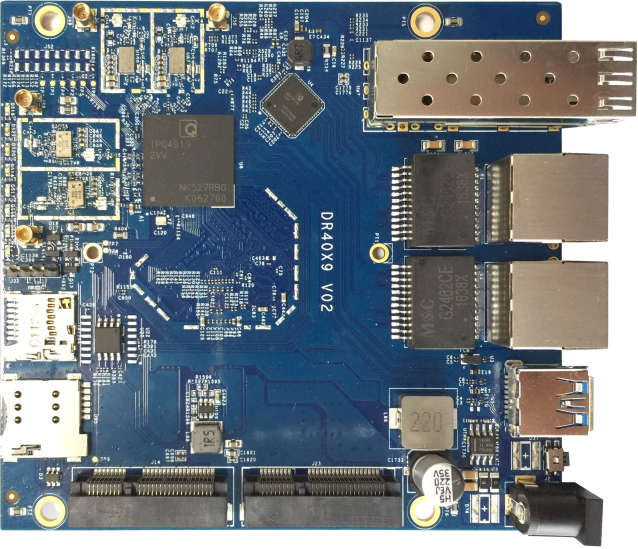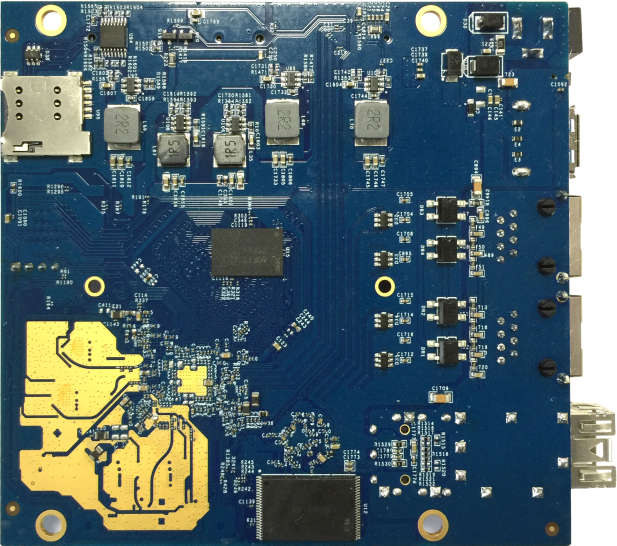Qualcomm is mostly known for its Snapdragon processors for mobile devices and wearables, but the company is also making WiFi chipsets via their (previously) “Atheros” family. Some of their latest WiFi SoCs are IPQ4019 and IPQ4029 (aka QCA4019/QCA4029) Wave-2 802.11ac “Dakota” SoCs for routers, gateways, and access points.
We recently covered the official Qualcomm mesh networking devkit powered by IPQ4019 processor, but there are now third parties also offering solutions based on QCA40x9 processor such as Dakota DR40X9 Wave-2 AC router board.
 Dakota DR40X9 board specifications:
Dakota DR40X9 board specifications:
- SoC (one of the other)
- System Memory- 256MB~512MB DDR
- Storage – 2MB~32MB NOR Flash, 128MB NAND Flash, microSD card slot
- Connectivity
- Wired
- Dual 10/100/1000Mbps Gigabit Ethernet (RJ45)
- 1x optional SFP fiber module connector
- WiFi
- Dual-band 802.11ac Wave 2, 802.11ac, 802.11p, 802.11n up to 1.733 Gbps
- 2x 5GHz MMCX antenna connectors; 2x 2.4GHz MMCX antenna connectors
- 1x mini PCIe socket for an additional wireless card
- Cellular – 1x mini PCIe 3G/4G socket with two SIM cards
- Wired
- USB – 1xUSB 3.0 port
- Expansion – LED & GPIO header
- Misc – LED array, serial port, reset button
- Power Supply – 24V~48V DC via power barrel jack or passive POE
- Max Power Consumption – 48.1V x 0.180A= 8.658W
- Dimensions – 115 x 105 x 16mm
- Temperature Range – Operating: -40 to +70°C; storage: -45 to +105°C
- Compliance – ROHS
The only differences between IPQ4019 and IPQ4029 are that the latter supports “Qualcomm IoT Connectivity”, and an extended temperature range of -40°C to +110°C.

There’s very little information about software on the web, but representatives at Wallys Communications (Suzhou) Co informed me there were two software/firmware options for the board:
- Official QSDK with Linux 3.14 (Requires NDA)
- Latest OpenWrt image using dk04 build
I’m unclear whether there’s any advantage of getting the QSDK considering the older kernel. For reference, QSDK stands for “QCA Software Development Kit (QSDK)” and additional information may be found on CodeAurora Wiki. There’s also mention of OpenWrt with Linux 4.4 kernel compatible with ipq40xx, but it remains to be seen if it is compatible with Dakota DR40X9 board.
Typical use cases for the board include security & surveillance application, commercial radio coverage, hotel wireless application, forest fire protection engineering, etc…
I could not get public pricing for the board, but at least two companies are offering it: Wallys Communications (Suzhou) Co and Maxon (Beijing).

Jean-Luc started CNX Software in 2010 as a part-time endeavor, before quitting his job as a software engineering manager, and starting to write daily news, and reviews full time later in 2011.
Support CNX Software! Donate via cryptocurrencies, become a Patron on Patreon, or purchase goods on Amazon or Aliexpress




